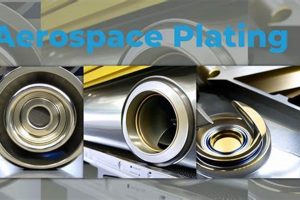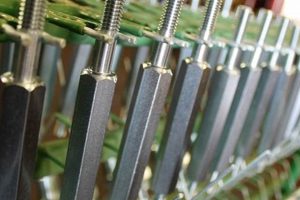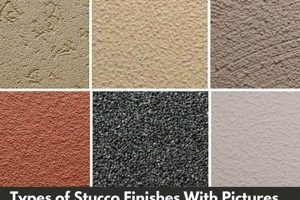A dark-toned surface treatment applied to metallic substrates, the process imparts a distinctive aesthetic characterized by its deep color. This outcome is achieved through various methods, including powder coating, anodizing, and chemical treatments. These processes alter the surface of the metal, creating a durable and visually appealing layer. An example would be hardware found on modern cabinetry, providing a sleek contrast to lighter surfaces.
The adoption of dark-colored surface treatments for metal items offers multiple advantages. It increases resistance to corrosion and wear, extending the lifespan of the underlying material. Historically, such treatments were primarily utilitarian, providing protection against the elements. However, they now serve a significant aesthetic purpose, enhancing the visual appeal of products across industries ranging from architecture to consumer electronics. The resulting surfaces complement a wide range of design styles, from industrial to minimalist.
The following sections will delve into specific techniques used to achieve the desired aesthetic, exploring the unique properties of each method. A comparison of the durability, cost-effectiveness, and environmental impact of different surface treatments will also be presented. Furthermore, applications in various industries will be highlighted, providing a comprehensive overview of this increasingly popular surface treatment option.
Considerations for Dark-Toned Metallic Surfaces
The following guidelines offer crucial insights when specifying or working with dark-toned metal surfaces, ensuring optimal performance and longevity.
Tip 1: Select the Appropriate Treatment Method: The choice of surface treatment, whether powder coating, anodizing, or chemical conversion, must align with the intended application and environmental conditions. Powder coating provides excellent durability and color options but may be thicker than anodizing, which offers superior corrosion resistance and intricate detail preservation.
Tip 2: Address Substrate Preparation: Proper surface preparation is paramount. Thorough cleaning and degreasing remove contaminants that impede adhesion and compromise the coating’s integrity. Surface profiling, such as blasting, creates an anchor pattern, enhancing the bond between the substrate and the finish.
Tip 3: Control Coating Thickness: Maintain consistent coating thickness within specified tolerances. Excessive thickness can lead to cracking or chipping, while insufficient thickness compromises protection against corrosion and wear. Adhere to manufacturer guidelines for optimal performance.
Tip 4: Consider Environmental Factors: Understand the intended environment. Exterior applications necessitate UV-resistant coatings to prevent fading and degradation. Marine environments demand superior corrosion protection through specialized alloys and coatings.
Tip 5: Evaluate Color Matching and Consistency: Ensure color consistency across different batches and components. Specify color standards and tolerances to minimize variations. Employ spectrophotometric analysis to verify color accuracy.
Tip 6: Assess Abrasion Resistance: Evaluate the coating’s abrasion resistance based on the anticipated level of wear. Harder coatings, such as those achieved through certain powder coating formulations or specialized anodizing processes, offer superior scratch resistance.
Tip 7: Implement Quality Control Measures: Establish rigorous quality control protocols throughout the finishing process. Regular inspections, adhesion tests, and corrosion resistance tests ensure adherence to specifications and identify potential defects early.
These guidelines underscore the importance of careful planning and execution when utilizing dark-toned metal surface treatments. Attention to these factors will result in enhanced durability, aesthetic appeal, and long-term performance.
The subsequent sections will explore specific applications and case studies illustrating the practical implementation of these guidelines.
1. Aesthetics
Aesthetics constitute a primary driver in the specification of dark-toned metallic surfaces. The visual characteristics achieved through various treatment methods significantly influence product appeal and market perception.
- Color Uniformity and Depth
Color consistency across a finished product is crucial for a premium appearance. Achieving deep, uniform color necessitates precise control over the surface treatment process. Variations in color depth can detract from the perceived quality, especially in applications where multiple components are assembled. Examples include architectural hardware where subtle color mismatches can be readily apparent.
- Surface Texture and Reflectivity
The texture of the finished surface, ranging from matte to glossy, dramatically affects the visual impact. Matte surfaces diffuse light, minimizing glare and fingerprints, while glossy surfaces reflect light, creating a sleek, modern aesthetic. The choice depends on the intended application and desired user experience. For instance, control panels may benefit from matte finishes to reduce eye strain.
- Design Versatility and Compatibility
Dark-toned surface treatments offer considerable design flexibility, complementing a wide range of materials and styles. This versatility allows for integration into diverse product lines and architectural designs. The neutrality of the color allows for seamless integration with various color palettes and materials. An example can be found in interior design where it harmonizes with both natural and synthetic materials.
- Perception of Quality and Luxury
The use of surface treatments can elevate the perceived quality of a product. The association of a dark finish with high-end materials and craftsmanship can justify premium pricing. This perception is particularly relevant in industries such as automotive and consumer electronics, where aesthetics play a significant role in purchase decisions.
In summary, the aesthetic considerations surrounding dark-toned metallic surfaces extend beyond mere color selection. The interplay of color uniformity, surface texture, design versatility, and perceived quality collectively shapes the visual appeal and market value of the finished product. The selection of a surface treatment method should therefore prioritize these aesthetic factors to achieve the desired impact.
2. Corrosion resistance
Corrosion resistance constitutes a critical performance characteristic in dark-toned metallic surface treatments. The susceptibility of metals to degradation via electrochemical reactions with their environment necessitates protective measures. The application of specific surface treatments is directly linked to the mitigation of corrosive processes. A failure to address corrosion can lead to structural weakening, aesthetic degradation, and ultimately, premature failure of the metallic component. For example, steel components exposed to marine environments require surface treatments capable of withstanding high salinity and humidity to prevent rapid oxidation.
The effectiveness of surface treatments in enhancing corrosion resistance depends on the specific method employed. Anodizing, for example, creates a thick oxide layer on aluminum, significantly increasing its resistance to atmospheric and chemical corrosion. Powder coating, on the other hand, provides a barrier between the metal substrate and the environment, preventing corrosive agents from reaching the metal surface. Chemical conversion coatings, such as phosphate coatings, form a chemically inert layer that inhibits corrosion. The selection of the appropriate surface treatment method must therefore consider the anticipated environmental conditions and the specific corrosion mechanisms prevalent in those conditions. A practical example involves the automotive industry, where underbody components receive specialized coatings to withstand road salts and moisture, thus extending their lifespan.
Understanding the connection between the surface treatment and corrosion resistance is paramount for ensuring the longevity and reliability of metallic components. The selection process should account for the corrosive potential of the operating environment, the material properties of the substrate, and the specific protective mechanisms offered by the selected surface treatment. Furthermore, regular inspection and maintenance are essential to identify and address any signs of corrosion before they compromise the structural integrity of the component. The application of suitable dark-toned surface treatments significantly contributes to long-term performance and minimizes the risk of corrosion-related failures, thus promoting sustainability and reducing the lifecycle costs associated with metallic structures and products.
3. Abrasion Resistance
Abrasion resistance, defined as the ability of a surface to withstand mechanical wear resulting from frictional contact, is a crucial performance parameter in evaluating the suitability of a dark-toned metallic surface treatment. The connection between abrasion resistance and these finishes is direct: the inherent hardness and durability of the applied coating determine its capacity to maintain its aesthetic and protective qualities under conditions of repeated rubbing, scratching, or erosion. A surface treatment with poor abrasion resistance will exhibit premature wear, leading to the exposure of the underlying substrate, a compromised aesthetic, and a reduced lifespan. Consider, for instance, architectural hardware such as door handles or handrails. These items are subject to constant contact; a durable surface treatment is critical to preventing the removal of the dark finish and subsequent exposure of the base metal. The practical significance of understanding this connection lies in informing the selection of the appropriate treatment method based on the anticipated wear conditions.
The abrasion resistance of dark-toned surface treatments varies significantly depending on the application technique and the materials employed. Powder coating, for example, typically provides a thicker and more durable layer compared to anodizing, offering superior protection against scratching and chipping. However, specialized anodizing processes can enhance the hardness of the oxide layer, improving its resistance to abrasion. Chemical conversion coatings, while providing corrosion protection, generally offer limited abrasion resistance and are therefore more suitable for applications with minimal mechanical contact. Real-world examples abound; the selection of a surface treatment for industrial machinery components must prioritize abrasion resistance to withstand the rigors of continuous operation, whereas a decorative element may place greater emphasis on aesthetics, potentially sacrificing some abrasion resistance for a particular visual effect.
In conclusion, abrasion resistance is an integral attribute of dark-toned surface treatments, directly influencing their longevity and performance. The selection of a suitable finish requires a careful assessment of the anticipated wear conditions, the inherent properties of the treatment method, and the performance trade-offs between abrasion resistance, aesthetics, and cost. Addressing the challenge of balancing these factors necessitates a comprehensive understanding of the materials science and engineering principles governing the behavior of these finishes under mechanical stress. This understanding is essential for ensuring that the selected treatment provides the desired aesthetic appeal while maintaining its protective function throughout the intended service life, thereby maximizing value and minimizing the need for premature replacement.
4. Application Method
The application method constitutes a critical determinant in the final characteristics of dark-toned metallic surfaces. The chosen technique directly influences the coating’s adhesion, thickness, uniformity, and ultimately, its performance attributes such as corrosion and abrasion resistance. Distinct methods, including powder coating, anodizing, and chemical conversion, yield divergent results. The selection must align with the substrate material, desired aesthetic, performance criteria, and cost constraints. Failure to account for these interdependencies results in suboptimal outcomes, potentially leading to premature coating failure or aesthetic deficiencies. For instance, applying powder coating to a component requiring tight dimensional tolerances may be inappropriate due to the relatively thick layer imparted by the process. The practical significance lies in the recognition that the application method is not merely a procedural step but an integral component defining the integrity and suitability of the final product.
Anodizing, for example, relies on electrochemical oxidation to create a durable oxide layer integral to the aluminum substrate. This method allows for precise control over coating thickness and offers excellent corrosion resistance, making it suitable for aerospace and automotive applications. Powder coating, conversely, involves the electrostatic application of pigmented polymer powder, followed by heat curing to form a robust, uniform layer. This method offers a wider range of color options and can be applied to various metals, but may not be ideal for intricate geometries due to potential Faraday cage effects. Chemical conversion coatings, such as black oxide or phosphate coatings, rely on chemical reactions to form a protective layer on the metal surface. These methods are typically less expensive but offer limited abrasion resistance, making them suitable for internal components or parts with minimal exposure to wear. The choice of method therefore dictates the performance profile and aesthetic characteristics of the final surface, influencing its suitability for specific applications.
In summary, the application method is intrinsically linked to the properties and performance of dark-toned metallic surfaces. Careful consideration of the substrate material, desired attributes, and cost factors is essential for selecting the optimal technique. Addressing the challenges associated with each method, such as achieving uniform coverage on complex shapes or controlling coating thickness within precise tolerances, requires expertise and adherence to industry best practices. Understanding this fundamental connection ensures the creation of durable, aesthetically pleasing, and functionally appropriate surface treatments that meet the demands of diverse engineering and design applications, thus maximizing the lifespan and value of the finished product.
5. Substrate Material
The selection of the substrate material directly influences the characteristics and suitability of dark-toned metallic surface treatments. The inherent properties of the base metal, including its composition, hardness, and surface reactivity, dictate the methods that can be effectively employed and the resulting performance of the finish. A mismatch between the substrate and the surface treatment can lead to compromised adhesion, accelerated corrosion, or undesirable aesthetic outcomes. Therefore, a thorough understanding of the interplay between the substrate and the finish is essential for achieving optimal results.
- Alloy Composition and Reactivity
The chemical composition of the metal alloy significantly impacts its reactivity with various surface treatment processes. For instance, high-carbon steels require different pre-treatment steps compared to stainless steels to ensure proper adhesion of coatings. Similarly, the presence of alloying elements such as chromium or nickel can influence the corrosion resistance of the substrate and the overall performance of the finish. The specific alloy composition must therefore be considered when selecting the appropriate treatment method. Consider the contrasting surface preparation requirements of aluminum alloys versus ferrous alloys before the application of powder coating.
- Surface Roughness and Texture
The initial surface condition of the substrate plays a critical role in the adhesion and uniformity of dark-toned metallic finishes. Rough surfaces provide greater mechanical interlocking for coatings, enhancing adhesion but potentially affecting the aesthetic appearance. Smooth surfaces, on the other hand, may require specific etching or profiling treatments to promote adequate adhesion. The desired surface roughness must be balanced with the aesthetic requirements of the application. An example would be the difference in surface preparation for a brushed stainless steel versus a polished aluminum substrate prior to anodization.
- Mechanical Properties and Hardness
The mechanical properties of the substrate, particularly its hardness and yield strength, influence the durability and scratch resistance of the finished product. Softer metals are more susceptible to damage from abrasion or impact, necessitating the application of thicker or harder coatings to provide adequate protection. The substrate’s mechanical properties must therefore be considered when selecting a surface treatment with appropriate abrasion resistance. For example, titanium substrates benefit from specific surface treatments that enhance their inherent hardness for demanding aerospace applications.
- Thermal Expansion Coefficient
The coefficient of thermal expansion of the substrate material affects the long-term integrity of the applied coating. Differences in thermal expansion between the substrate and the finish can induce stress during temperature fluctuations, leading to cracking, delamination, or other forms of coating failure. Selecting surface treatments with compatible thermal expansion characteristics is crucial for applications exposed to varying temperatures. Consider the potential for stress cracking when applying a rigid coating to a substrate with a significantly higher coefficient of thermal expansion, such as certain plastics with a metallic coating.
In conclusion, the substrate material’s properties, including its alloy composition, surface roughness, mechanical characteristics, and thermal behavior, directly impact the selection and performance of dark-toned metallic surface treatments. A comprehensive understanding of these interdependencies is paramount for achieving optimal results, ensuring long-term durability, and meeting the stringent aesthetic and functional requirements of diverse engineering and design applications. Neglecting these factors can lead to premature failure, compromised performance, and increased lifecycle costs.
6. Cost-effectiveness
Cost-effectiveness forms a critical consideration in the implementation of dark-toned metallic surface treatments. The economic viability of selecting a particular finish hinges on balancing the initial investment with the long-term benefits derived from enhanced durability, aesthetic appeal, and reduced maintenance requirements. Various factors contribute to the overall cost, including material costs, labor expenses, energy consumption, and the complexity of the application process. A comprehensive cost-benefit analysis is crucial for determining the most suitable option for a given application, factoring in not only the upfront expenses but also the projected lifespan and potential for cost savings over time. For instance, while anodizing might present a higher initial cost compared to powder coating, its superior corrosion resistance in harsh environments could translate to lower maintenance and replacement costs in the long run.
The selection of surface treatment directly impacts manufacturing efficiencies and material utilization. Powder coating, with its ability to reclaim and reuse overspray, minimizes waste and contributes to a more cost-effective process compared to liquid-based coating systems. Similarly, the ease of application and shorter curing times associated with certain methods can reduce labor costs and increase throughput, thereby improving overall production efficiency. Examples include the use of automated powder coating lines in the automotive industry, which enable high-volume production with consistent quality and minimal material waste. Further, the choice of substrate material interacts with the surface treatment cost; a more expensive substrate might warrant a more durable finish to maximize its lifespan and return on investment.
In summary, cost-effectiveness in dark-toned metallic surface treatments is a multifaceted issue encompassing initial expenses, long-term performance, and manufacturing efficiencies. A thorough assessment of all relevant cost factors, coupled with a clear understanding of the application’s specific requirements, is essential for making informed decisions that optimize value and minimize lifecycle costs. The challenge lies in balancing the desire for enhanced aesthetics and durability with the economic realities of production, requiring a comprehensive approach that considers both tangible and intangible benefits. This analysis ultimately ensures that the selected surface treatment represents a prudent investment, providing long-term value and contributing to the overall competitiveness of the finished product.
7. Maintenance Requirements
Maintenance requirements are intrinsically linked to the long-term performance and aesthetic appeal of dark-toned metallic surfaces. The inherent characteristics of the chosen surface treatment, combined with the environmental conditions to which the finished product is exposed, directly influence the frequency and intensity of required maintenance procedures. Neglecting appropriate maintenance can lead to premature degradation of the finish, resulting in corrosion, discoloration, or loss of protective properties. For instance, architectural components with surfaces located in coastal environments necessitate regular cleaning to remove salt deposits that accelerate corrosion. The practical significance of understanding this connection lies in the ability to proactively implement maintenance strategies that extend the lifespan and preserve the intended appearance of the finish.
Specific surface treatments exhibit distinct maintenance profiles. Anodized aluminum, while generally durable, may require periodic cleaning with mild detergents to prevent the build-up of surface contaminants that can dull its appearance. Powder-coated surfaces, known for their resilience, may benefit from occasional waxing to enhance their gloss and provide an additional layer of protection against environmental pollutants. Chemical conversion coatings, offering relatively lower abrasion resistance, may necessitate more frequent inspections and touch-up repairs to address minor scratches or wear. The maintenance schedule should consider the anticipated exposure conditions; for example, surfaces subjected to high levels of UV radiation may require coatings formulated with UV inhibitors and more frequent reapplication of protective sealants. The selection of cleaning agents and maintenance procedures must also be compatible with the specific finish to avoid damaging or discoloring the surface. The automotive industry exemplifies this, where specialized cleaning products are formulated for various types of paint and protective coatings, ensuring long-term preservation of the vehicle’s finish.
In summary, maintenance requirements are an essential consideration when specifying dark-toned metallic surface treatments. Understanding the connection between the finish type, environmental conditions, and required maintenance procedures enables proactive management, thereby extending the lifespan, preserving aesthetic appeal, and maximizing the long-term value. The challenge lies in integrating appropriate maintenance strategies into routine operational procedures, ensuring that these measures are consistently implemented to mitigate the risk of premature degradation and maintain the desired performance characteristics of the finish. This holistic approach, encompassing material selection, application method, and ongoing maintenance, is crucial for achieving sustainable and cost-effective solutions that meet the demanding requirements of diverse engineering and design applications.
Frequently Asked Questions
The following addresses common inquiries and misconceptions regarding dark-toned metallic surface treatments. It aims to provide clear, concise answers to enhance understanding.
Question 1: What constitutes a “dark-toned metallic surface”?
It refers to a metallic substrate with a surface treatment designed to impart a dark, often black or near-black, aesthetic. The treatment can involve various methods, including powder coating, anodizing, or chemical conversion, to alter the surface’s visual appearance and protective properties.
Question 2: What advantages do these surfaces offer compared to traditional finishes?
They offer a combination of aesthetic appeal and functional benefits. Aesthetically, they provide a modern and sophisticated look. Functionally, they can enhance corrosion resistance, abrasion resistance, and UV protection, depending on the specific treatment applied.
Question 3: Are these treatments suitable for all metal types?
No. The suitability depends on the specific treatment method and the metal’s inherent properties. Anodizing, for example, is primarily used on aluminum, while powder coating can be applied to various metals, including steel and aluminum. Chemical compatibility is critical.
Question 4: How does the application method affect the performance of the finish?
The application method significantly influences the coating’s adhesion, thickness, uniformity, and ultimately, its protective properties. Each method presents unique advantages and limitations. Therefore, the choice of method must align with the desired performance criteria and substrate material.
Question 5: What are the typical maintenance requirements for these surfaces?
Maintenance requirements vary depending on the surface treatment and the environmental conditions. Regular cleaning with mild detergents is generally recommended. Some finishes may benefit from periodic waxing or sealing to enhance their protective qualities. Specific manufacturer guidelines should be consulted.
Question 6: What factors influence the cost of these surface treatments?
Cost is influenced by several factors, including the type of treatment, the size and complexity of the component, the substrate material, and the volume of production. A thorough cost-benefit analysis should be conducted to determine the most economical option for a given application.
These frequently asked questions provide a foundational understanding. Further research and consultation with experts are recommended for specific applications.
The following section explores practical applications and case studies demonstrating the real-world use of these surfaces.
Conclusion
The preceding examination of dark-toned metal surfaces has elucidated the critical factors governing their selection, application, and long-term performance. Emphasis has been placed on the interconnectedness of aesthetics, corrosion resistance, abrasion resistance, application methods, substrate material, cost-effectiveness, and maintenance requirements. A comprehensive understanding of these elements is essential for achieving optimal outcomes in diverse engineering and design applications. Improper consideration of these facets invariably leads to compromised performance, increased lifecycle costs, and ultimately, product failure.
The informed application of black metal finishes provides opportunities for enhanced product design and durability. However, success depends on rigorous assessment and planning. Further research and adherence to industry best practices remain paramount for continued advancement in this domain, ensuring the responsible and effective utilization of these materials in the future.


![Top Asheville Metal Finishing: [Your Brand] Quality Safem Fabrication - Precision Engineering & Custom Manufacturing Solutions Top Asheville Metal Finishing: [Your Brand] Quality | Safem Fabrication - Precision Engineering & Custom Manufacturing Solutions](https://bestfinaltouch.com/wp-content/uploads/2025/06/th-876-300x200.jpg)




